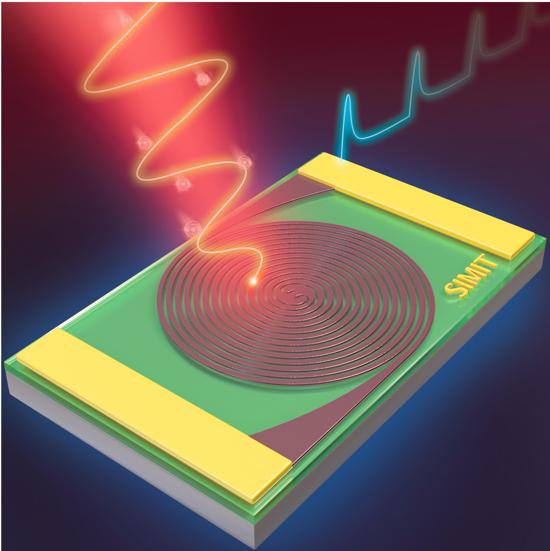Superconducting single-photon detectors (SSPDs) play a key role in the fields of quantum information processing, quantum optics, deep-space laser communications, and light detection and ranging, owing to high system detection efficiency (SDE), low dark count rate (DCR), low timing jitter (TJ), high photon count rate, and broadband sensitivity.
To detect single photons with high sensitivity, SSPDs are usually fabricated in a nanowire structure with wire widths on the order of 100 nm using electron beam lithography (EBL), called superconducting nanowire single-photon detectors (SNSPDs).
However, mass production of SNSPDs with large active area still faces various technical challenges, such as the cost of EBL, low yield due to the increasing probability of constrictions, and lower detection speed attributed to the long nanowire.
In 2017, Russian scientists proposed a theoretical prediction that a "dirty" superconducting strip with micrometer-scale width may detect single optical photons when it permits bias currents close to the intrinsic depairing current of unpatterned film. In 2018, Russian scientists experimentally verified the feasibility of detecting single photons using a micrometer-scale bridge. The detection behavior was attributed to high material homogeneity and minimal geometrical constrictions in the device. This new type of detector is called a superconducting microstrip single-photon detector (SMSPD).
Compared with an SNSPD with the same active area, an SMSPD has several advantages, such as smaller kinetic inductance (faster in detection speed), higher working current (lower TJ), and lower processing accuracy requirements. SMSPD provides a very promising route to the fabrication of large-active-area detectors or detector arrays by photolithography, as well as high-yield production. Thus, the study of SMSPD has attracted emerging research activities.
In 2020, researchers from the National Institute of Standards and Technology and the Massachusetts Institute of Technology separately reported the realization of saturated detection of infrared photons at 1550 nm by using large-active-area SMSPDs made of the low-energy gap amorphous materials WSi or MoSi. However, the performance was mediocre, and the possibility of a high-performance and practical SMSPD remains an open question.
Researchers at the Shanghai Institute of Microsystem and Information Technology, Chinese Academy of Sciences (SIMIT, CAS) have reported an SMSPD made of polycrystalline niobium nitride (NbN) that can achieve an SDE exceeding 90% (up to 92.2% at 0.84 K) at 1550 nm. The results are published in Photonics Research, Volume 9, No. 6, 2021 (Guang-Zhao Xu, Wei-Jun Zhang, Li-Xing You, et al. Superconducting microstrip single-photon detector with system detection efficiency over 90% at 1550 nm[J]. Photonics Research, 2021, 9(6): 06000958).
In this research article, the SDE of the NbN type detector is boosted by adopting a novel technology through pretreating the NbN films with helium ion irradiation, which results in a higher probability of a hotspot (normal state domain) being generated in the microstrip. This technology was developed previously by the same team [W.-J. Zhang et al., Phys. Rev. Appl. 12, 044040 (2019)].
The detector was comprised of a double spiral strip, which had a strip width of ~1 μm and covered a 50-μm-diameter active area. The spiral configuration was used to reduce the influence of the geometrical induced "current-crowding effect", thus improving the maximum bias current. Combined with an optimized optical structure design, a high-efficiency detector has been successfully demonstrated.
The researchers also found that SMSPD can achieve a low DCR (~200 cps) and a low TJ (~48 ps) comparable to the conventional SNSPD. The polarization sensitivity of the detector is only 1.03 due to the high filling factor design (filling factor ~80%). In addition, when the detector was operated in a closed-cycle cryostat at 2.1 K, its SDE still exceeded 70%. Owing to the large active area, when the detector is coupled with a multimode fiber, its maximum SDE exceeds 60% with a TJ of ~50 ps. "To the best of our knowledge, these performance indices far exceed other SMSPDs of the same type at present. Luckily, we are running in the fast lane," The co-first author Guangzhao Xu said, who is a young Phd candidate at SIMIT.

Superconducting microstrip single-photon detector (SMSPD). A double spiral strip configuration with a width of ~1 μm is used to form a 50-μm-diameter active detector area.
"In contrast to conventional methods, such as varying the stoichiometry of the superconducting thin film to improve photon sensitivity, this study used an ion irradiation technology, which is a mature semiconductor industry process and can precisely tune the density and depth distribution of the irradiation-induced vacancy defects in the thin film.
Furthermore, this approach can be carried out before, during, or after the device is fabricated, and the irradiation dose can be cumulative. This technology shows good performance in flexibility, controllability, and repeatability, and will be particularly useful for research and development of high-performance SMSPDs, as well as for the study of the detection mechanism," SIMIT researcher Wei-Jun Zhang said.
"However, further studies are necessary, such as the fabrication of SMSPDs with millimeter-scale active areas and high performance, or methods for replacing EBL with deep ultraviolet lithography for SMSPDs. Regardless, this study shows great potential for SMSPDs in practical applications. We are optimistic about the future of SMSPDs," SIMIT researcher Li-Xing You said.


